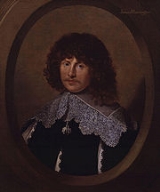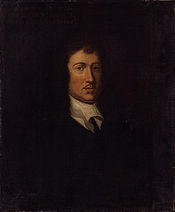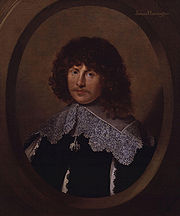
James Harrington
Encyclopedia

England
England is a country that is part of the United Kingdom. It shares land borders with Scotland to the north and Wales to the west; the Irish Sea is to the north west, the Celtic Sea to the south west, with the North Sea to the east and the English Channel to the south separating it from continental...
political theorist of classical republicanism
Classical republicanism
Classical republicanism is a form of republicanism developed in the Renaissance inspired by the governmental forms and writings of classical antiquity. The earliest examples of the school were classical writers such as Aristotle, Polybius, and Cicero...
, best known for his controversial work, The Commonwealth of Oceana
The Commonwealth of Oceana
The Commonwealth of Oceana, published 1656, is a composition of political philosophy written by the English politician and essayist, James Harrington . When first attempted to be published, it was officially censored by Lord Protector Oliver Cromwell...
(1656).
Early life

Upton, Northamptonshire
Upton is a civil parish north-east of Kislingbury and south-west of Dallington, in Northamptonshire, England about west of Northampton town centre along the A45 road. Formerly a scattered hamlet, it is now part of the town...
, eldest son of Sir
Sir
Sir is an honorific used as a title , or as a courtesy title to address a man without using his given or family name in many English speaking cultures...
Sapcote(s) Harrington of Rand, Lincolnshire
Rand, Lincolnshire
Rand is a small village and civil parish in the West Lindsey district of Lincolnshire, England, approximately north east of the city of Lincoln and approximately west of Wragby, just off the A158 road from Lincoln to Skegness in the East Midlands region. The nearest large town is Market Rasen,...
who died 1629, and great-nephew of the first Lord Harington of Exton
Harington Baronets
The Harington'Baronetcy, of Ridlington in the County of Rutland, is a title in the Baronetage of England. It was created on 29 June 1611 for James Harington. He was a descendant of John Harington, one of the Barons summoned to Parliament by Edward II...
who died 1615. His mother was Jane Samwell (or Samuell) of Upton, daughter of Sir William Samwell
Sir William Samwell
Sir William Samwell was an Auditor of the Exchequer to Queen Elizabeth I of England. He was knighted at the coronation of King James I of England in 1603....
. He was also for a time a resident, with his father, in the Manor House
Manor house
A manor house is a country house that historically formed the administrative centre of a manor, the lowest unit of territorial organisation in the feudal system in Europe. The term is applied to country houses that belonged to the gentry and other grand stately homes...
at the village of Milton Malsor
Milton Malsor
Milton Malsor is a village and civil parish in South Northamptonshire, England. It is south of Northampton, south-east of Birmingham, and north of central London; junction 15 of the M1 motorway is east by road...
, Northamptonshire. A blue plaque
Blue plaque
A blue plaque is a permanent sign installed in a public place to commemorate a link between that location and a famous person or event, serving as a historical marker....
on the Manor house marks this fact. The village church contains a quite decorative plaque on the Chancel
Chancel
In church architecture, the chancel is the space around the altar in the sanctuary at the liturgical east end of a traditional Christian church building...
wall, on the south side, to Dame
Knight
A knight was a member of a class of lower nobility in the High Middle Ages.By the Late Middle Ages, the rank had become associated with the ideals of chivalry, a code of conduct for the perfect courtly Christian warrior....
Jane, the late wife of Sir Sapcote(s). According to a memorial in Holy Cross Church in Milton, she died on 30 March 1619 when James was 7 or 8 years old.
The memorial reads, in modern English but punctuated as in the original
"Here under lies the body of Dame Jane, daughter of Sir William Samwell Knight, & late wife to Sir Sapcotes Harington(sicSicSic—generally inside square brackets, [sic], and occasionally parentheses, —when added just after a quote or reprinted text, indicates the passage appears exactly as in the original source...
) of Milton Knight, by whom he had issue 2 sons & 3 daughters, viz James, William, Jane, Anne & Elizabeth. Which Lady died March 30, 1619".
Childhood and education
Knowledge of Harrington's childhood and early education is practically non-existent; both, it seems, were conducted at the family manor in Rand. In 1629, he entered Trinity College, OxfordTrinity College, Oxford
The College of the Holy and Undivided Trinity in the University of Oxford, of the foundation of Sir Thomas Pope , or Trinity College for short, is one of the constituent colleges of the University of Oxford in England. It stands on Broad Street, next door to Balliol College and Blackwells bookshop,...
as a gentleman commoner and left two years later with no degree. For a brief time, one of his tutors was the royalist High Churchman William Chillingworth
William Chillingworth
William Chillingworth was a controversial English churchman.-Early life:He was born in Oxford, where his father served as mayor; William Laud was his godfather. In June 1618 he became a scholar of Trinity College, Oxford, of which he was made a fellow in June 1628...
. He entered then abruptly left the Middle Temple
Middle Temple
The Honourable Society of the Middle Temple, commonly known as Middle Temple, is one of the four Inns of Court exclusively entitled to call their members to the English Bar as barristers; the others being the Inner Temple, Gray's Inn and Lincoln's Inn...
despising lawyers forever, an animus which later appeared in his writings.
Youth

Pope
The Pope is the Bishop of Rome, a position that makes him the leader of the worldwide Catholic Church . In the Catholic Church, the Pope is regarded as the successor of Saint Peter, the Apostle...
's foot' , and that a trip through Venice helped bolster his knowledge of the Italian republics. Harrington appears to have returned to England no later than 1636. The following decade, including his comings and goings during the Civil Wars, are largely unaccounted for by anything other than unsubstantiated stories of the ilk: that he accompanied Charles I to Scotland in 1639 in connection with the first Bishops' War
Bishops' Wars
The Bishops' Wars , were conflicts, both political and military, which occurred in 1639 and 1640 centred around the nature of the governance of the Church of Scotland, and the rights and powers of the Crown...
; and that he came to Parliament's financial assistance with loans and solicitations in 1641-42 and in 1645. Otherwise, he appears to have simply "resided at Rand, an unmarried country gentleman of studious tastes."
Harrington's apparent political loyalty to Parliament interfered not all with a strong personal devotion to the King. Following his capture, Harrington accompanied a "commission" of MPs appointed to persuade Charles to move from Newcastle
Newcastle upon Tyne
Newcastle upon Tyne is a city and metropolitan borough of Tyne and Wear, in North East England. Historically a part of Northumberland, it is situated on the north bank of the River Tyne...
to Holmby House
Holdenby House
Holdenby House is a historic country house in Northamptonshire, traditionally pronounced and sometimes spelt Holmby. The house is situated in the parish of Holdenby, six miles northwest of Northampton and close to Althorp....
, as to be nearer London. When a further attempt was made to forcibly transfer the King to the capital, Harrington successfully intervened. In May 1647, he became a gentleman groom of the royal bedchamber
Groom of the Chamber
Groom of the Chamber and Groom of the Privy Chamber were positions in the Royal Household of the English monarchy, the latter considerably more elevated. Other Ancien Régime royal establishments in Europe had comparable officers, often with similar titles...
; we see him acting in that capacity through the end of the year and also in 1648 at Hurst Castle
Hurst Castle
Hurst Castle on the south coast of England is one of Henry VIII's Device Forts, built at the end of a long shingle barrier beach at the west end of the Solent to guard the approaches to Southampton. Hurst Castle was sited at the narrow entrance to the Solent where the ebb and flow of the tides...
and at Carisbrooke
Carisbrooke Castle
Carisbrooke Castle is a historic motte-and-bailey castle located in the village of Carisbrooke, near Newport, Isle of Wight, England. Charles I was imprisoned at the castle in the months prior to his trial.-Early history:...
. Sometime around New Year 1649, his attendance on the King was abruptly terminated by parliamentarians furious, it is said, over his refusal to swear to report anything he might hear of a royal escape attempt. At least two contemporary accounts have Harrington with Charles on the scaffold, but these do not rise above the level of rumor.
Oceana and imprisonment

Lord Protector
Lord Protector is a title used in British constitutional law for certain heads of state at different periods of history. It is also a particular title for the British Heads of State in respect to the established church...
Oliver Cromwell
Oliver Cromwell
Oliver Cromwell was an English military and political leader who overthrew the English monarchy and temporarily turned England into a republican Commonwealth, and served as Lord Protector of England, Scotland, and Ireland....
, it was seized when passing through the press. Harrington, however managed to secure the favour of Cromwell's favourite daughter, Mrs Claypole; the work was restored to him, and appeared in 1656, newly dedicated to Cromwell. The views embodied in Oceana, particularly those bearing on vote by ballot and rotation of magistrates and legislators, Harrington and others (who in 1659 formed a club called the "Rota
Rota Club
The Rota Club refers to a debate society, composed of learned gentlemen, who debated republican ideology in London between November 1659 and February 1660. The Club was founded and dominated by James Harrington...
") endeavoured to push practically, but with no success.
Following the Stuart Restoration, on 28 December 1661, Harrington was arrested on a charge of conspiring against the government in the "Bow Street" cabal
Cabal
A cabal is a group of people united in some close design together, usually to promote their private views and/or interests in a church, state, or other community, often by intrigue...
and, without a trial, was thrown into the Tower
Tower of London
Her Majesty's Royal Palace and Fortress, more commonly known as the Tower of London, is a historic castle on the north bank of the River Thames in central London, England. It lies within the London Borough of Tower Hamlets, separated from the eastern edge of the City of London by the open space...
. There, he was "badly treated" until his sisters succeeded in bribing his jailers to obtain a writ of habeas corpus
Habeas corpus
is a writ, or legal action, through which a prisoner can be released from unlawful detention. The remedy can be sought by the prisoner or by another person coming to his aid. Habeas corpus originated in the English legal system, but it is now available in many nations...
. Before it could be executed, however, the authorities rushed him to St Nicholas Island off the coast of Plymouth
Plymouth
Plymouth is a city and unitary authority area on the coast of Devon, England, about south-west of London. It is built between the mouths of the rivers Plym to the east and Tamar to the west, where they join Plymouth Sound...
. Other relatives won Harrington's release to the fort at Plymouth by posting a £5000 bond. Thereafter, his general state of health promptly plunged and quickly deteriorated, apparently from his ingestion on medical advice of the addictive drug guaiacum
Guaiacum
Guaiacum, sometimes spelled Guajacum, is a genus of flowering plants in the caltrop family Zygophyllaceae. It contains five species of slow-growing shrubs and trees, reaching a height of approximately but are usually less than half of that...
.
Harrington's mind appeared to be affected. He suffered "intermittent delusions;" one observer judged him "simply mad." He recovered only slightly, then slipped decidedly downhill. He proceeded to suffer attacks of gout and palsy before falling victim to a paralyzing stroke. In 1675, just two years before his death, he married "a Mrs Dayrell, his 'old sweetheart'", the daughter of a Buckinghamshire noble. The short-lived couple had no children. Following his death at Little Ambry, he was buried next to Sir Walter Raleigh in St Margaret's Church
St. Margaret's, Westminster
The Anglican church of St. Margaret, Westminster Abbey is situated in the grounds of Westminster Abbey on Parliament Square, and is the parish church of the House of Commons of the United Kingdom in London...
, Westminster
Westminster
Westminster is an area of central London, within the City of Westminster, England. It lies on the north bank of the River Thames, southwest of the City of London and southwest of Charing Cross...
.
Harrington has often been confused with his cousin Sir James Harrington, 3rd Baronet of Ridlington, MP, a member of the parliamentary commission which tried Charles I, and twice president of Cromwell's Council of State. He was subsequently excluded from the Indemnity and Oblivion Act
Indemnity and Oblivion Act
The Indemnity and Oblivion Act 1660 is an Act of the Parliament of England , the long title of which is "An Act of Free and General Pardon, Indemnity, and Oblivion"....
which pardoned most for taking up arms against the King during the Civil Wars (1642–1646).
Editorial history
Harrington's manuscripts have vanished; his printed writings consist of Oceana, and papers, pamphlets, aphorisms and treatises, many of which are devoted to its defence. The first two editions are known as the "Chapman" and the "Pakeman". Their contents are nearly identical. His Works, including the Pakeman Oceana and the somewhat important A System of Politics, were first edited with biography by John TolandJohn Toland
John Toland was a rationalist philosopher and freethinker, and occasional satirist, who wrote numerous books and pamphlets on political philosophy and philosophy of religion, which are early expressions of the philosophy of the Age of Enlightenment...
in 1700. Toland's edition, with numerous substantial additions by Thomas Birch
Thomas Birch
Thomas Birch was an English historian.-Life:He was the son of Joseph Birch, a coffee-mill maker, and was born at Clerkenwell....
, appeared first in Dublin in 1737 and 1758, and then in England in 1747 and 1771. Oceana was reprinted in Henry Morley's Universal Library in 1883; S.B. Liljegren reissued a fastidiously-prepared version of the Pakeman edition in 1924.
Harrington's modern editor is J. G. A. Pocock. In 1977, he edited a comprehensive compilation of Harrington tracts, with a lengthy historical introduction. Harrington's prose was marred by what Pocock described as an undisciplined work habit and a conspicuous "lack of sophistication." He never attained the level of "a great literary stylist." For example, as contrasted with Hobbes and Milton, nowhere to be found are:
"important shades of meaning...conveyed [through] rhythm, emphasis and punctuation; ...He wrote hastily, in a baroque and periodic style in which he more than once lost his way. He suffered from Latinisms...his notions of how to insert quotations, translations and references in his text were at times productive of confusion."
Further reading
- Blitzer, Charles. An Immortal Commonwealth: the Political Thought of James Harrington (Hamden, Conn.: Archon Books, 1970;1960); [ISBN 0-208-00811-X].
- Cotton, James. James Harrington's Political Thought and its Context (New York: Garland Pub., 1991); [ISBN 0-8153-0130-8].
- Dickinson, W. Calvin. James Harrington's Republic (Washington, DC: University Press of America, 1983); [ISBN 0-8191-3019-2].
- Downs, Michael. James Harrington (Boston: Twayne Pubs., 1977); [ISBN 0-8057-6693-6].
- Pocock, J.G.A. "Interregnum: the Oceana of James Harrington", chapter 6 in Pocock, The Ancient Constitution and the Feudal Law: a Study of English Historical Thought in the Seventeenth Century, a reissue with a retrospect (Cambridge: 1987;1957); [pb: ISBN 0-521-31643-X].
- Pocock, The Work of J.G.A. Pocock: Harrington section.
- Robbins, Caroline. The Eighteenth-Century Commonwealthman: Studies in the Transmission, Development, and Circumstance of English Liberal Thought from the Restoration of Charles II until the War with the Thirteen Colonies (1959, 2004). table of contents online
- Russell-Smith, Hugh Francis. Harrington and his Oceana; a story of a 17th century Utopia and its influence in America (New York: Octagon Books, 1971); [ISBN 0-374-96996-5].
- Scott, Jonathan. "The Rapture of Motion: James Harrington's Republicanism", in Nicholas Phillipson; Quentin Skinner, eds. Political Discourse in Early Modern Britain (Cambridge: 1993), 139-163; [ISBN 0-521-39242-X].

